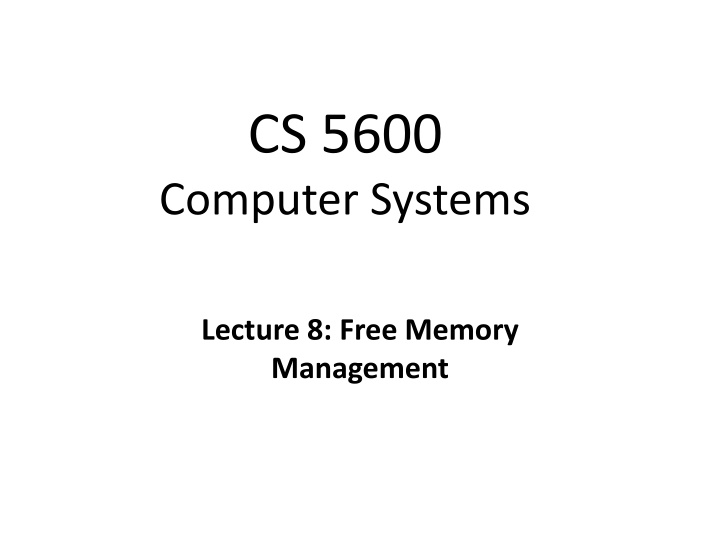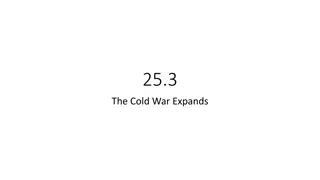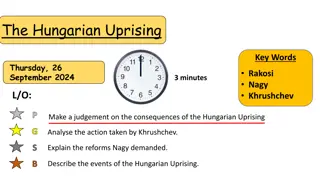University Cultures in the Post-Soviet Era: Education Development
Delve into the various subcultures within universities in the post-Soviet era, as explored by Andrey Shcherbenok from Moscow School of Management SKOLKOVO. Gain insights into the evolving educational landscape.
Uploaded on Feb 19, 2025 | 2 Views
Download Presentation

Please find below an Image/Link to download the presentation.
The content on the website is provided AS IS for your information and personal use only. It may not be sold, licensed, or shared on other websites without obtaining consent from the author.If you encounter any issues during the download, it is possible that the publisher has removed the file from their server.
You are allowed to download the files provided on this website for personal or commercial use, subject to the condition that they are used lawfully. All files are the property of their respective owners.
The content on the website is provided AS IS for your information and personal use only. It may not be sold, licensed, or shared on other websites without obtaining consent from the author.
E N D
Presentation Transcript
CS 5600 Computer Systems Lecture 8: Free Memory Management
Recap of Last Week Last week focused on virtual memory Gives each process the illusion of vast, empty memory Offers protection and isolation 31 24 23 16 15 8 7 0 PD Index PT Index Offset Page Directory Physical Memory Page Tables CR3 Register 2
Dynamic Allocation of Pages Virtual Memory Page tables allow the OS to dynamically assign physical frames to processes on-demand E.g. if the stack grows, the OS can map in an additional page On Linux, processes use sbrk()/brk()/mmap() to request additional heap pages But, these syscalls only allocates memory in multiples of 4KB pages ESP Stack Stack Stack Heap Heap Heap Code 3
What About malloc() and free()? The OS only allocates and frees memory in units of 4KB pages What if you want to allocate <4KB of memory? E.g. char * string = (char *) malloc(100); Each process manages its own heap memory On Linux, glibc implements malloc() and free(), manages objects on the heap The JVM uses a garbage collector to manage the heap There are many different strategies for managing free memory 4
Free Space Management Todays topic: how do processes manage free memory? 1. Explicit memory management Languages like C, C++; programmers control memory allocation and deallocation 2. Implicit memory management Languages like Java, Javascript, Python; runtime takes care of freeing useless objects from memory In both cases, software must keep track of the memory that is in use or available 5
Why Should You Care? Regardless of language, all of our code uses dynamic memory However, there is a performance cost associated with using dynamic memory Understanding how the heap is managed leads to: More performant applications The ability to diagnose difficult memory related errors and performance bottlenecks 6
Key Challenges Maximizing CPU performance Keeping track of memory usage requires effort Maximize parallelism Heap memory is shared across threads Thus, synchronization may be necessary Minimizing memory overhead Metadata is needed to track memory usage This metadata adds to the size of each object Minimize fragmentation Over time, deallocations create useless gaps in memory 7
Free Lists Basics Speeding Up malloc() and free() Slab Allocation Common Bugs Garbage Collectors Reference Counting Mark and Sweep Generational/Ephemeral GC Parallel Garbage Collection 8
Setting the Stage Many languages allow programmers to explicitly allocate and deallocate memory C, C++ malloc() and free() Programmers can malloc() any size of memory Not limited to 4KB pages free() takes a pointer, but not a size How does free() know how many bytes to deallocate? Pointers to allocated memory are returned to the programmer As opposed to Java or C# where pointers are managed Code may modify these pointers 9
Requirements and Goals Keep track of memory usage What bytes of the heap are currently allocated/unallocated? Store the size of each allocation So that free() will work with just a pointer Minimize fragmentation without doing compaction or relocation More on this later Maintain higher performance O(1) operations are obviously faster than O(n), etc. 10
Heap Fragmentation obj * obj1, * obj2; hash_tbl * ht; int array[]; char * str1, * str2; free(obj2); free(array); str2 = (char *) malloc(300); Heap Memory str1 array str2 ht obj2 This is an example of external fragmentation There is enough empty space for str2, but the space isn t usable As we will see, internal fragmentation may also be an issue obj1 12
The Free List Design challenge: linked lists are dynamic data structures Dynamic data structures go on the heap But in this case, we are implementing the heap?! A free list is a simple data structure for managing heap memory Three key components 1. A linked-list that records free regions of memory Free regions get split when memory is allocated Free list is kept in sorted order by memory address 2. Each allocated block of memory has a header that records the size of the block 3. An algorithm that selects which free region of memory to use for each allocation request 13
Free List Data Structures Heap Memory (4KB) The free list is a linked list Stored in heap memory, alongside other data For malloc(n): num_bytes = n +sizeof(header) typedef struct node_t { int size; struct node_t * next; } node; Linked list of regions of free space size = bytes of free space Header for each block of allocated space size = bytes of allocated space typedef struct header_t { int size; } header; next 4088 node * head 14
Code to Initialize a Heap // mmap() returns a pointer to a chunk of free space node * head = mmap(NULL, 4096, PROT_READ|PROT_WRITE, MAP_ANON|MAP_PRIVATE, -1, 0); head->size = 4096 sizeof(node); head->next = NULL; 15
Allocating Memory (Splitting) Heap Memory (4KB) char * s1 = (char *) malloc(100); // 104 bytes char * s2 = (char *) malloc(100); // 104 bytes char * s3 = (char *) malloc(100); // 104 bytes next 3776 node * head typedef struct node_t { int size; struct node_t * next; } node; next 3880 100 char * s3 Free region is split into allocated and free regions node * head next 3984 100 char * s2 node * head typedef struct header_t { int size; } header; next 4088 100 char * s1 node * head Header 16
Freeing Memory Heap Memory (4KB) The free list is kept in sorted order free() is an O(n) operation free(s2); // returns 100 + 4 8 bytes free(s1); // returns 100 + 4 - 8 bytes free(s3); // returns 100 + 4 - 8 bytes All memory is free, but the free list divided into four regions next 3776 node * head typedef struct node_t { int size; struct node_t * next; } node; next char * s3 100 96 next These pointers are dangling : they still point to heap memory, but the pointers are invalid char * s2 100 96 node * head typedef struct header_t { int size; } header; next char * s1 100 96 node * head 17
Coalescing Heap Memory (4KB) Free regions should be merged with their neighbors Helps to minimize fragmentation This would be O(n2) if the list was not sorted next 3776 typedef struct node_t { int size; struct node_t * next; } node; next 96 next 96 typedef struct header_t { int size; } header; next 96 200 304 4088 node * head 18
Choosing Free Regions (1) Heap Memory (4KB) int i[] = (int*) malloc(8); // 8 + 4 = 12 total bytes next 3596 char * s2 Which free region should be chosen? Fastest option is First-Fit Split the first free region with >=8 bytes available Problem with First-Fit? Leads to external fragmentation next 16 char * s1 next 38 node * head next 50 int i[] node * head
Choosing Free Regions (2) Heap Memory (4KB) int i[] = (int*) malloc(8); // 8 + 4 = 12 total bytes next 3596 char * s2 Second option: Best-Fit Locate the free region with size closest to (and >=) 8 bytes Less external fragmentation than First-fit Problem with Best-Fit? Requires O(n) time next 4 next 16 int i[] char * s1 next 50 node * head
Basic Free List Review Singly-linked free list List is kept in sorted order free() is an O(n) operation Adjacent free regions are coalesced Various strategies for selecting which free region to use for a given malloc(n) First-fit: use the first free region with >=n bytes available Worst-case is O(n), but typically much faster Tends to lead to external fragmentation at the head of the list Best-fit: use the region with size closest (and >=) to n Less external fragments than first-fit, but O(n) time 21
Improving Performance 1. Use a circular linked list and Next-Fit Faster than Best-Fit, less fragmentation than First-fit 2. Use a doubly-linked free list with footers Good: makes free() and coalesce O(1) time Bad: small amount of memory wasted due to headers and footers 3. Use bins to quickly locate appropriately sized free regions Good: much less external fragmentation, O(1) time Bad: much more complicated implementation Bad: some memory wasted due to internal fragmentation 22
Circular List and Next-Fit Heap Memory (4KB) int i[] = (int*) malloc(8); next 3596 1. Change to a singly-linked, circular linked list 2. Use First-Fit, but move head after each split Known as Next-Fit Helps spread allocations, reduce fragmentation Faster allocations than Best-Fit char * s2 next 16 node * head char * s1 next 38 next 50 int i[] node * head
Towards O(1) free() free() is O(n) because the free list must be kept in sorted order Key ideas: Move to a doubly linked list Add footers to each block Enables coalescing without sorting the free list Thus, free() becomes O(1) typedef struct node_t { bool free; int size; struct node_t * next; struct node_t * prev; } node; typedef struct header_t { bool free; int size; } header; typedef struct footer_t { int size; } header; 24
Example Blocks typedef struct node_t { bool free; int size; struct node_t * next; struct node_t * prev; } node; Footer Free Block Allocated Block next typedef struct header_t { bool free; int size; } header; prev typedef struct footer_t { int size; } header; 25
Locating Adjacent Free Blocks Suppose we have free(i) Locate the next and previous free blocks Heap Memory (4KB) hn char * p = (char *) i; // for convenience // header of the current block header * h = (header *) (p sizeof(header)); // header of the next block header * hn = (header *) (p + h->size + sizeof(footer)); // previous footer footer * f = (footer *) (p sizeof(header) sizeof(footer)); // previous header header * hp = (header *) ((char *) f f->size sizeof(header)); int * i h hp 26
Coalescing is O(1) node * n = (node *) h, nn, np; n->free = true; if (hn->free) { // combine with the next free block nn = (node *) hn; n->next = nn->next; n->prev = nn->prev; nn->next->prev = n; nn->prev->next = n; n->size += nn->size + sizeof(header) + sizeof(footer); ((footer *) ((char *) n + n->size))->size = n->size; } if (hp->free) { // combine with the previous free block np = (node *) hp; np->size += n->size + sizeof(header) + sizeof(footer); ((footer *) ((char *) np + np->size))->size = np->size; } if (!hp->free && !hn->free) { // add the new free block to the head of the free list } Be careful of corner cases: The first free block The last free block 27
Speeding Up malloc() At this point, free() is O(1) But malloc() still has problems Next-Fit: O(1) but more fragmentation Best-Fit: O(n) but less fragmentation Two steps to speed up malloc() 1. Round allocation requests to powers of 2 Less external fragmentation, some internal fragmentation 2. Divide the free list into bins of similar size blocks Locating a free block of size round(x) will be O(1) 28
Rounding Allocations malloc(size) size += sizeof(header) + sizeof(footer); // will always be >16 bytes if (size > 2048) size = 4096 * ((size + 4095) / 4096); else if (size < 128) size = 32 * ((size + 31) / 32); else size = round_to_next_power_of_two(size); For large allocations, use full pages Examples: malloc(4) 32 bytes malloc(45) 64 bytes malloc(145) 256 bytes 29
Binning Divided the free list into bins of exact size blocks Most allocations handled in O(1) time by pulling a free block from the appropriate list If no block is available, locate and split a larger block node * bins[]; 32 bytes 64 bytes 96 bytes 128 bytes 256 bytes 512 bytes 1024 bytes 2048+ bytes 30
Next Problem: Parallelism Today s programs are often parallel However, our current memory manager has poor performance with >1 threads CPU 1 CPU 2 Thread 1 Thread 2 Thread 1 Thread 2 obj1 obj2 Cache Line Free List Allocations are filled sequentially in memory Objects for different threads may share the same cache line This causes contention between CPU cores The free list is shared, thus it must be protected by a mutex
Per-Thread Arenas To reduce lock and CPU cache contention, divide the heap into arenas Each arena has its own free list Each thread is assigned to several arenas Thread 1 Thread 2 Thread 3 No (or few) shared locks Cache affinity is high unless data is shared between threads Arena 2 Arena 3 Arena 1 Arena 5 Arena 6 Arena 4 32
Two More Things How can you make your code manage memory more quickly? Slab allocation Common memory bugs Memory leaks Dangling pointers Double free 33
Speeding Up Your Code Typically, the memory allocation algorithm is not under your control You don t choose what library to use (e.g. glibc) You don t know the internal implementation How can your make your code faster? Avoid the memory allocator altogether! Use an object cache plus slab allocation 34
template<class T> class obj_cache { private: stack<T *> free_objs; Objects are allocated in bulk Less space wasted on headers and footers void allocate_slab() { T * objs = (T *) malloc(sizeof(T) * 10); for (int x = 0; x < 10; ++x) free_objs.push(&objs[x]); } public: obj_cache() { allocate_slab(); } // start by pre-allocating some objects T * alloc() { if (free_objs.empty()) allocate_slab(); // allocate more if we run out T * obj = free_objs.top(); free_objs.pop(); return obj; // return an available object } }; void free(T * obj) { free_objs.push(obj); } // return obj to the pool 35
Two More Things How can you make your code manage memory more quickly? Slab allocation Common memory bugs Memory leaks Dangling pointers Double free 36
Memory Management Bugs (1) int search_file(char * filename, char * search) { unsigned int size; char * data; FILE * fp = fopen(filename, "r"); fseek(fp, 0, SEEK_END); size = ftell(fp); data = (char *) malloc(size * sizeof(char)); fseek(fp, 0, SEEK_SET); fread(data, 1, size, fp); return strstr(data, search) > 0; } // Open the file // Seek to the end of the file // Tell me the total length of the file // Allocate buffer // Seek back to the beginning of the file // Read the whole file into the buffer // Is the search string in the buffer? If this program ran for a long time, eventually it would exhaust all available virtual memory We forgot to free(data)! void main(int argc, char ** argv) { if (search_file(argv[1], argv[2])) printf("String '%s' found in file '%s'\n", argv[2], argv[1]); else printf("String '%s' NOT found in file '%s'\n", argv[2], argv[1]); } 37
Memory Management Bugs (2) Dangling pointer char * s = (char *) malloc(100); free(s); puts(s); Double free char * s = (char *) malloc(100); free(s); free(s); Behavior is nondeterministic If the memory has no been reused, may print s If the memory has been recycled, may print garbage Typically, this corrupts the free list However, your program may not crash (nondeterminism) In some cases, double free bugs are exploitable 38
Free Lists Basics Speeding Up malloc() and free() Slab Allocation Common Bugs Garbage Collectors Reference Counting Mark and Sweep Generational/Ephemeral GC Parallel Garbage Collection 39
Brief Recap At this point, we have thoroughly covered how malloc() and free() can be implemented Free lists of varying complexity Modern implementations are optimized for low fragmentation, high parallelism What about languages that automatically manage memory? Java, Javascript, C#, Perl, Python, PHP, Ruby, etc 40
Garbage Collection Invented in 1959 Automatic memory management The GC reclaims memory occupied by objects that are no longer in use Such objects are called garbage Conceptually simple 1. Scan objects in memory, identify objects that cannot be accessed (now, or in the future) 2. Reclaim these garbage objects In practice, very tricky to implement 41
Garbage Collection Concepts Root Nodes Stack Global Variables int * p; struct linked_list * head; What objects are reachable? Garbage Heap 42
Identifying Pointers At the assembly level, anything can be a pointer int x = 0x80FCE42; char * c = (char *) x; // this is legal Challenge: how can the GC identify pointers? 1. Conservative approach: assume any number that might be a pointer, is a pointer Problem: may erroneously determine (due to false pointers) that some blocks of memory are in use 2. Deterministic approach: use a type-safe language that does not allow the programmer to use unboxed values as pointers, or perform pointer arithmetic 43
Approaches to GC Reference Counting Each object keeps a count of references If an objects count == 0, it is garbage Mark and Sweep Starting at the roots, traverse objects and mark them Free all unmarked objects on the heap Copy Collection Extends mark & sweep with compaction Addresses CPU and external fragmentation issues Generational Collection Uses heuristics to improve the runtime of mark & sweep 44
Reference Counting Key idea: each object includes a ref_count Assume obj * p = NULL; p = obj1; // obj1->ref_count++ p = obj2; // obj1->ref_count--, obj2->ref_count++ If an object s ref_count == 0, it is garbage No pointers target that object Thus, it can be safely freed 45
Reference Counting Example Root Nodes Stack Global Variables int * p; struct linked_list * head; 1 2 1 0 1 0 1 2 3 1 1 1 1 These objects are garbage, but none have ref_count == 0 Heap 46
Pros and Cons of Reference Counting The Good The Bad Relatively easy to implement Easy to conceptualize Not guaranteed to free all garbage objects Additional overhead (int ref_count) on all objects Access to obj->ref_count must be synchronized 47
Mark and Sweep Key idea: periodically scan all objects for reachability Start at the roots Traverse all reachable objects, mark them All unmarked objects are garbage 48
Mark and Sweep Example Root Nodes Stack Global Variables int * p; struct linked_list * head; Heap 49
Mark and Sweep Example Root Nodes Stack Global Variables int * p; struct linked_list * head; Correctly identifies unreachable cycles as garbage Heap 50
Pros and Cons of Mark and Sweep The Good The Bad Mark and sweep is CPU intensive Traverses all objects reachable from the root Scans all objects in memory freeing unmarked objects Na ve implementations stop the world before collecting Threads cannot run in parallel with the GC All threads get stopped while the GC runs Overcomes the weakness of reference counting Fairly easy to implement and conceptualize Guaranteed to free all garbage objects Be careful: if you forget to set a reference to NULL, it will never be collected (i.e. Java can leak memory) 51



![[PDF⚡READ❤ONLINE] Energiya-Buran: The Soviet Space Shuttle (Springer Praxis Book](/thumb/21613/pdf-read-online-energiya-buran-the-soviet-space-shuttle-springer-praxis-book.jpg)



















